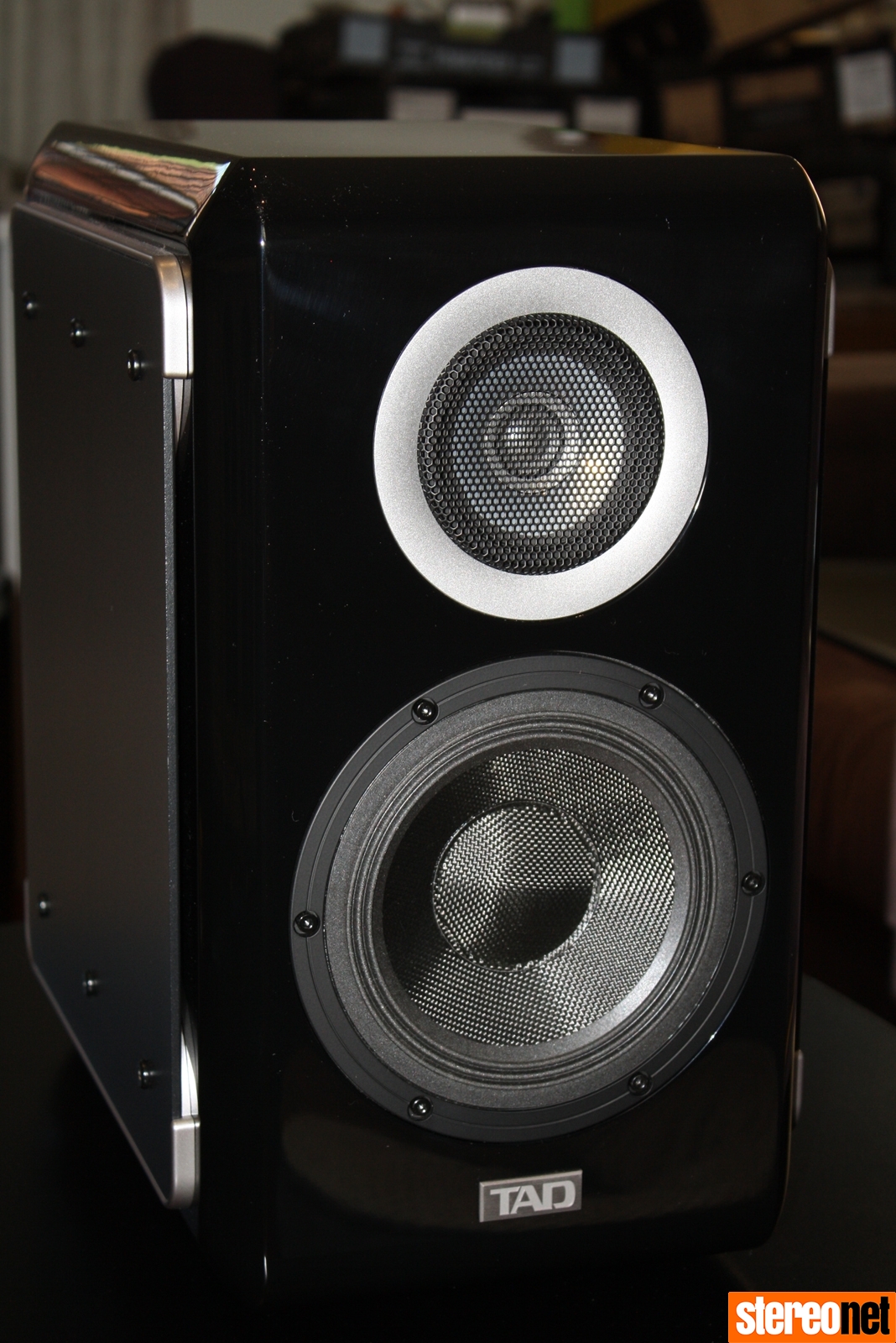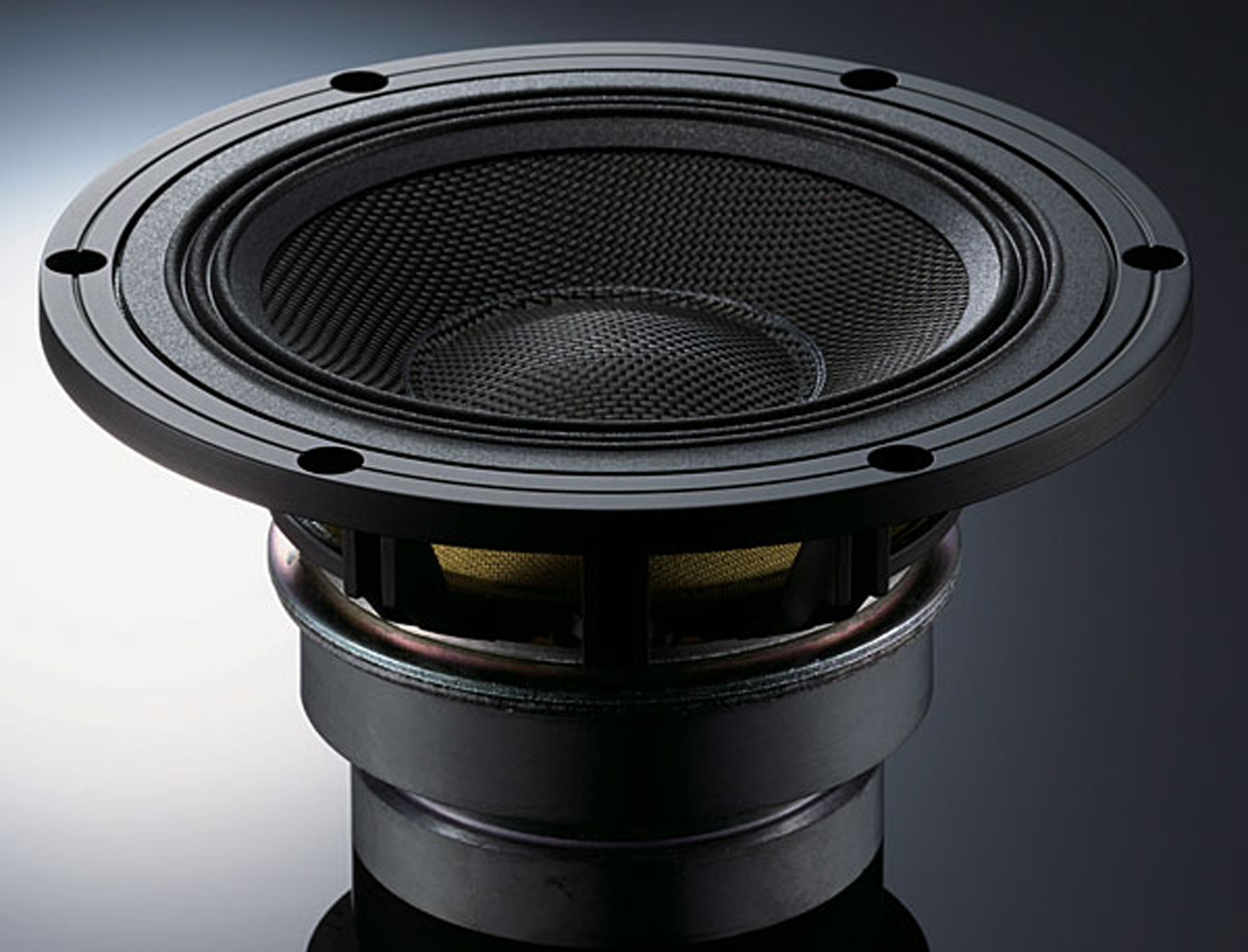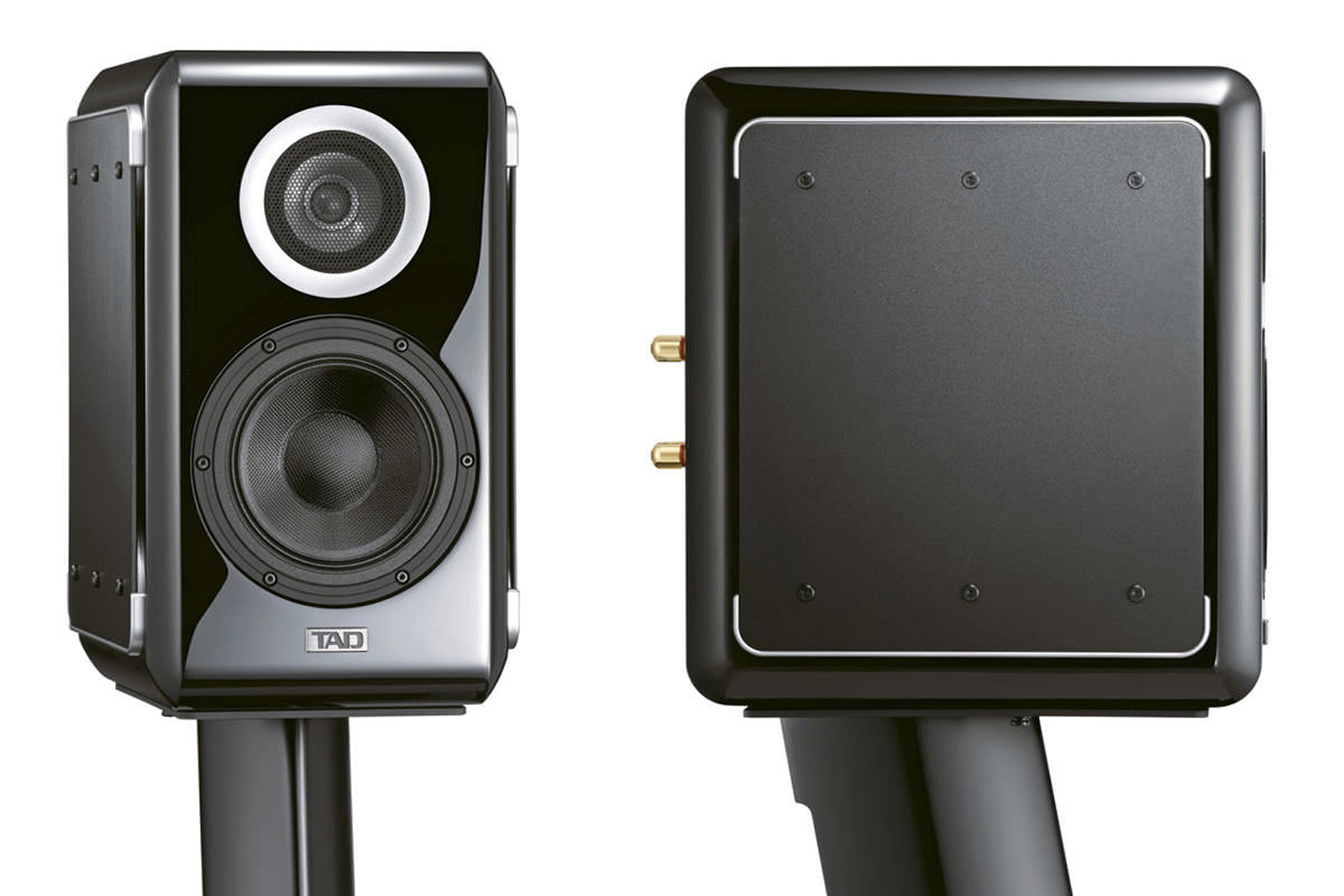TAD Micro Evolution One Stand Mount Loudspeaker Review

Mark Gusew is beguiled by what's undoubtedly one of the most significant new high-end standmounters around…
TAD
ME-1 Stand Mount Loudspeakers
£10,500 RRP

Technical Audio Devices Laboratories, Inc. remains one of high-end hi-fi's best-kept secrets. Most audiophiles won't have heard a TAD loudspeaker; it was only at a hi-fi show that I first encountered the brand several years ago. It was created by Pioneer in 1975 to make reference loudspeakers for Japan's professional audio market. Since 2003 the company has branched out into the consumer sphere with speakers and electronics, albeit operating at the very top of the market. Not your average High Street brand, then.
Costing a cool £10,500 with matching stands, the Micro Evolution One (ME1) is TAD's entry-level loudspeaker – its smallest and least expensive offering! It sports a 160mm woofer that works with a unique Coherent Source Transducer coaxial midrange/tweeter driver. The 25mm dome tweeter is mounted concentrically within the 90mm midrange cone, effectively becoming a point source of sound. Other manufacturers like KEF, with its Uni-Q driver, for instance, use a similar type of design. As the two drivers share the same acoustic centre, they are time-coherent and have matched directivity, which produces nicely controlled radiation patterns of both direct and reflecting sounds.

The tweeter uses a pure Beryllium diaphragm; chemistry boffins will know this to be the lightest stable metal in the Periodic Table. Its low mass and strength make it a superb material for the job in hand, but it is costly and hard to work with. The midrange is made of magnesium, a slightly heavier self-damping metal that's also super-stiff. The woofer cone is made of woven and non-woven aramid fibre fabric that's separately formed then laminated together, making it very stiff and with ideal characteristics within its operating frequency range.
According to the published specifications, the coaxial CST driver covers a wide bandwidth from 420Hz to 60kHz, the tweeter crossing over above 2.5kHz with the woofer below 420Hz. The result is a claimed frequency response of 36Hz to 60kHz, without mention of any tolerances. It has a rated sensitivity of 85dB (2.83V, 1m) and a nominal impedance of 4 ohms, so isn't a walk in the park to drive – you'll need a powerful amplifier that can easily deal with low impedance loads.

These drive units are held in place by a high-rigidity, low resonance cabinet constructed by laminating Baltic birch plywood combined with MDF. It's heavy, dense and inert – indeed the knuckle rap test tells me that this is probably the most lifeless cabinet I've ever come across, and is like tapping a rock! Each side has a 4mm thick structural steel plate bolted on that helps reduce unnecessary resonances from the cabinet and acts as a cover plate for the bass reflex ports.
Under the steel plate is what the manufacturer calls a Bi-Directional Aero-Dynamic Slot – a symmetrical horn-shaped port cut into each side of the cabinet that's claimed to take care of internal standing waves. There is a 3mm gap between the cabinet and the plate to allow the sound out, but it doesn't suffer from port chuffing due to its profile. This brilliant design allows the speaker to go deep cleanly, despite its modest dimensions. All up it weighs around 20kg per box. My review sample came finished in high gloss piano black that I'm told takes weeks to complete and is faultless. Build quality is first class; even the four binding posts at the rear are highly polished brass that looks and feel every bit of the asking price.

I used an Accustic Arts Power I Mk4 integrated amplifier, a TAD D1000MK2 disc player/preamp and TAD M1000 power amplifier for this review. The latter is said to be capable of 500W RMS per channel into 4 ohms. After about two hundred hours of use, my review pair settled down and developed a nice, deep bass and smooth, extended treble. This speaker needs significant playing time before it reaches its full potential.
I positioned the ME1s in the usual spot for speakers in my main listening room, and they worked well. However, with more experimentation, they ended up sounding best with a touch of bass reinforcement about 60cm from the front wall and a minimum of 1.5m from the nearest sidewalls. I used them 2m apart and sat about 3m away. They don't appear overly fussy when it comes to placement and happily work well in various locations. Some toe in was useful but didn't seem critical.

THE LISTENING
This super-smooth and refined sounding loudspeaker has the ability to extract everything from a track in high definition, and deliver it most palatably. It is accurate in the style of a studio monitor, with an even frequency response and the talent to play all music genres very well. It craves good recordings yet doesn't punish poor ones harshly, which I found admirable. It has the wonderful ability to conjure up vast, panoramic landscapes from stereo recordings, with loads of detail contained within.
For example, all the individual elements that make up Sound & Color by Alabama Shakes were portrayed in a clean and balanced way, with the recording itself determining the overall character of the sound. The ME1 is something of a chameleon that adapts to the source, sounding cool and aloof or colourful depending on the track being played. Like every great high-end loudspeaker, it has an uncanny ability to stay out of the way and not make itself the centre of attention.

Tonally, the ME1 is somewhat flatter in the bass than many, as it lacks an engineered 'bass hump' around 100Hz that so many standmount designs possess. This makes for a commendably linear bottom end that's also nicely extended, going deeper than you would think is possible for its modest size. The same goes for the midrange and treble regions; both are accurate, smooth and flat, and the latter extends upwards in a way that never seems to run out.
With such a wide overall frequency range, the ME1 has no trouble playing any type of music that you can think of. For instance, the pipe organ in the 1976 recording of O Helga natt by Oscars Motettkör was reproduced with astonishing ease when driven by a gutsy amplifier like the TAD M1000. It happily played much louder and cleaner than expected without the slightest sign of strain. The midrange integrated perfectly with the other frequencies to present a seamless top-to-bottom experience. The recording's massed voices were reproduced exceedingly well, with an air and space around each singer that made my spine tingle.

Midband detail is quite spectacular. The piano in Misty by Kate Bush sounded absolutely realistic, with virtually perfect attack, sustain and decay; the way that those notes drifted away was stunning. Nick Murphy's vocal in Low was beautifully rendered, with excellent instrumental separation. Via the ME1, densely recorded and near-impenetrable recordings were carefully unpacked and made listenable. Acoustic instruments and vocals were a particular treat, and I ended up listening to a lot of classical music due to this speaker's naturalness and transparency.
Speed is of the essence with electronic music, and the TAD scored highly here too – no doubt aided and abetted by those featherlight high-tech drive units. Welcome to the World of the Plastic Beach by Gorillaz featuring Snoop Dog has deep subsonic notes that the ME1 could resolve with a growl that excited both the listener and the room. Drums and bass had great attack, punch and definition – proof positive that the solid cabinet and its clever side ports were doing their jobs properly.

Spatially, the ME1 is seriously special. Tracks like Breezeblocks by alt-J and Gooey by Glass Animals sounded just right. Totally cohesive, it felt like Carolina Chocolate Drops Snowden's Jig was being performed right in front of me due to the fantastic transient speed and transparency. Correctly positioned, my pair of ME1s just disappeared into my listening room and let the music do all the talking. The soundstage of Paper Tiger by Beck was seriously wide and extended well beyond the actual loudspeakers, with the centre fill being particularly full and densely packed.
This standmounter isn't naturally forward in its presentation, yet it had an almost elastic sense of depth perspective. It moved the listener around, depending on the recorded acoustic – instead of rendering it flat or curtailed like many lesser loudspeakers. Essentially you get what's in the recording, no more and no less. For example, Elgar's Serenade for String Orchestra Op.20 by Daniel Hope was incredibly panoramic, with all members of the orchestra having their own place in space.

THE VERDICT
 TAD's new ME1 should be a destination for those wanting a small high-end loudspeaker with big sound capabilities. It is ultra-refined, accurate and articulate with near-full frequency range coverage. The way that it images and soundstages is uncanny. It can play softy or loudly, whilst remaining clean as the volume increases – a testimony to the inherent engineering talent at TAD. As befits a product of this price, it's made to incredibly high standards; its fit and finish are perfection in the way that only Japanese craftsmen know how to do. Hear this definitive new small speaker if you possibly can.
TAD's new ME1 should be a destination for those wanting a small high-end loudspeaker with big sound capabilities. It is ultra-refined, accurate and articulate with near-full frequency range coverage. The way that it images and soundstages is uncanny. It can play softy or loudly, whilst remaining clean as the volume increases – a testimony to the inherent engineering talent at TAD. As befits a product of this price, it's made to incredibly high standards; its fit and finish are perfection in the way that only Japanese craftsmen know how to do. Hear this definitive new small speaker if you possibly can.
For more information visit TAD
Mark Gusew
Starting his first audio consultancy business in the early ’80s whilst also working professionally in the electronics industry, Mark now splits his time between professional reviewing and AV consultancy.
Posted in: Applause Awards | 2020 | Loudspeakers | Bookshelf / Standmount | Hi-Fi | StereoLUX!
JOIN IN THE DISCUSSION
Want to share your opinion or get advice from other enthusiasts? Then head into the Message
Forums where thousands of other enthusiasts are communicating on a daily basis.
CLICK HERE FOR FREE MEMBERSHIP
Trending
applause awards
Each time StereoNET reviews a product, it is considered for an Applause Award. Winning one marks it out as a design of great quality and distinction – a special product in its class, on the grounds of either performance, value for money, or usually both.
Applause Awards are personally issued by StereoNET’s global Editor-in-Chief, David Price – who has over three decades of experience reviewing hi-fi products at the highest level – after consulting with our senior editorial team. They are not automatically given with all reviews, nor can manufacturers purchase them.
The StereoNET editorial team includes some of the world’s most experienced and respected hi-fi journalists with a vast wealth of knowledge. Some have edited popular English language hi-fi magazines, and others have been senior contributors to famous audio journals stretching back to the late 1970s. And we also employ professional IT and home theatre specialists who work at the cutting edge of today’s technology.
We believe that no other online hi-fi and home cinema resource offers such expert knowledge, so when StereoNET gives an Applause Award, it is a trustworthy hallmark of quality. Receiving such an award is the prerequisite to becoming eligible for our annual Product of the Year awards, awarded only to the finest designs in their respective categories. Buyers of hi-fi, home cinema, and headphones can be sure that a StereoNET Applause Award winner is worthy of your most serious attention.

























